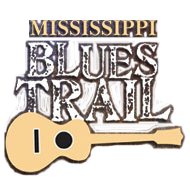Blue Front Cafe
Blue Front Cafe - Bentonia
The Blue Front Café opened in 1948 under the ownership of Carey and Mary Holmes, an African American couple from Bentonia. In its heyday the Blue Front was famed for its buffalo fish, blues, and moonshine whiskey. One of the couple’s sons, Jimmy Holmes, took over the café in 1970 and continued to operate it as an informal, down-home blues venue that gained international fame among blues enthusiasts.
During the 1980s and ’90s the Blue Front Café began to attract tourists in search of authentic blues in a rustic setting. In its early years, the café was a local gathering spot for crowds of workers from the Yazoo County cotton fields. Carey and Mary Holmes raised their ten children and three nephews and sent most of them to college on the income generated by the café and their cotton crops. The café offered hot meals, groceries, drinks, recreation, entertainment, and even haircuts.
The Holmes family operated under a tangled set of local rules during the segregation era. TheBlue Front was subject to a 10 p.m. town curfew, but at the height of cotton gathering and ginning season, the café might stay open 24 hours a day to serve shifts of workers around the clock. The Blue Front could not serve Coca-Cola, however, nor could black customers purchase it or other items reserved for whites anywhere in Bentonia; African Americans were allowed only brands such as Nehi and Double Cola. Still, white customers regularly bought bootleg corn liquor at the back door of the café. After integration, the Blue Front boasted its own Coca-Cola sign.
Music at the Blue Front was often impromptu and unannounced. The café seldom advertised or formally booked acts. Many itinerant harmonica players and guitarists drifted through to play a few tunes, but at times the musical cast included such notables as Skip James, Jack Owens, Henry Stuckey, Sonny Boy Williamson No. 2 (Rice Miller), and James “Son” Thomas.
Local musicians who have played at the Blue Front also include harmonica players Bud Spires, Son Johnson, Bobby Batton, Alonzo (Lonzy) Wilkerson, and Cleo Pullman; guitarists Cornelius Bright, Jacob Stuckey, Dodd Stuckey, Tommy Lee West, owner Jimmy “Duck” Holmes, his brother John, their uncle Percy Smith, and cousin Otha Holmes; and, on special occasions, bands from Jackson led by Eddie Rasberry or Roosevelt Roberts. Musicians also performed at Carey Holmes’s outdoor gatherings on the family farm, which later evolved into the Bentonia Blues Festival, sponsored by Jimmy Holmes. In 2000, Mary Alice Holmes Towner, Jimmy’s sister, also organized a blues and gospel festival in Marks, Mississippi.
Jimmy Holmes’s first two CDs, released in 2006 and 2007, were recorded at the Blue Front, perpetuating the music he learned in Bentonia from Jack Owens and others.
Captions
Jimmy “Duck” Holmes assumed ownership of the Blue Front after his father Carey died in 1970. Mary Holmes, who cooked at the cafe, died in 1998. The Blue Front replaced a wooden structure that housed a market at this site in the 1940s.
Nehemiah “Skip” James was Bentonia’s most renowned blues singer. His 22-20 Blues, recorded in 1931, was the inspiration for Robert Johnson’s 32-20 Blues of 1936. He played guitar and piano at the Blue Front during one of his periodic stays in Bentonia (1948-53). Bentonia guitarist Jack Owens was part of the filming of a 1995 commercial for Levi’s ‘501 Blues shot at the Blue Front.
content © Mississippi Blues Commission
[ BACK TO TOP ]

